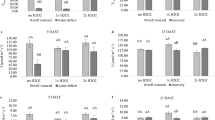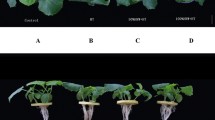Abstract
In the view of physiological role of H2O2, we investigated whether exogenous H2O2 application would affect short-term cold response of tomato and induce acclimation. Pretreatments were performed by immersing roots into 1 mM H2O2 solution for 1 h when transferring seedlings from seedling substrate to soil (acclimated group). Cold stress (3 °C for 16 h) caused significant reduction in relative water content (RWC) of control and non-acclimated (distilled water treated) groups when compared with unstressed plants. H2O2 promoted maintenance of relatively higher RWC under stress. Anthocyanin level in leaves of acclimated plants under cold stress was significantly higher than that of unstressed control and non-acclimated plants. Malondialdehyde (MDA) levels demonstrated low temperature induced oxidative damage to control and non-acclimated plants. MDA remained around unstressed conditions in acclimated plants, which demonstrate that H2O2 acclimation protected tissues against cold induced lipid peroxidation. H2O2 acclimation caused proline accumulation in roots under cold stress. Ascorbate peroxidase (APX) activity in roots of cold stressed and unstressed H2O2 acclimated plants increased when compared with control and non-acclimated plants, with highest increase in roots of acclimated plants under cold stress. CAT levels in roots of acclimated plants also increased, whereas levels remained unchanged in unstressed plants. Endogenous H2O2 levels significantly increased in roots of control and non-acclimated plants under cold stress. On the other hand, H2O2 content in roots of acclimated plants was significantly lower than control and non-acclimated plants under cold stress. The results presented here demonstrated that H2O2 significantly enhanced oxidative stress response by elevating the antioxidant status of tomato.




Similar content being viewed by others
References
Apel K, Hirt H (2004) Reactive oxygen species: metabolism, oxidative stress, and signal transduction. Annu Rev Plant Biol 55:373–399
Bates LS, Waldren RP, Teare ID (1973) Rapid determination of free proline for water-stress studies. Plant Soil 39:205–207
Beck EH, Heim R, Hansen J (2004) Plant resistance to cold stress: mechanisms and environmental signals triggering frost hardening and dehardening. J Biosci 29:449–459
Bernt E, Bergmeyer HU (1974) Inorganic peroxidasses. In: Bergmeyer HU (ed) Methods of enzymatic analysis. CRC Press, Boca Raton, pp 2246–2248
Bradford MM (1976) A rapid and sensitive method for the quantitation of microgram quantities of protein utilizing the principle of protein-dye binding. Anal Biochem 72:248–254
Chalker-Scott L (1999) Environmental significance of anthocyanins in plant stress responses. Photochem Photobiol 70:1–9
Chance B, Mahly AC (1995) Assay of catalases and peroxidases. Methods Enzymol 2:764–817
Chinnusamy V, Zhu J, Zhu J-K (2007) Cold stress regulation of gene expression in plants. Trends Plant Sci 12:444–451
de Azevedo Neto AD, Prisco JT, Enéas-Filho J, Medeiros JV, Gomes-Filho E (2005) Hydrogen peroxide pre-treatment induces salt-stress acclimation in maize plants. J Plant Physiol 162:1114–1122
Gechev T, Gadjev I, Breusegem FV, Inzé D, Dukiandjiev S, Toneva V, Minkov I (2002) Hydrogen peroxide protects tobacco from oxidative stress by inducing a set of antioxidant enzymes. Cell Mol Life Sci 59:708–714
Gilmour SJ, Sebolt AM, Salazar MP, Everard JD, Thomashow MF (2000) Overexpression of the Arabidopsis CBF3 transcriptional activator mimics multiple biochemical changes associated with cold acclimation. Plant Physiol 124:1854–1865
Giusti MM, Wrolstad RE (2001) Characterization and measurement of anthocyanins by UV–visible spectroscopy. Curr Protocols Food Anal Chem F1.2.1–F1.2.13
Gondim FA, Gomes-Filho E, Costa JH, Mendes Alencar NL, Prisco JT (2012) Catalase plays a key role in salt stress acclimation induced by hydrogen peroxide pretreatment in maize. Plant Physiol Biochem 56:62–71
Guan LM, Zhao J, Scandalios JG (2000) Cis-elements and trans-factors that regulate expression of the maize Cat1 antioxidant gene in response to ABA and osmotic stress: H2O2 is the likely intermediary signaling molecule for the response. Plant J 22:87–95
Holá D, Kočová M, Rothová O, Wilhelmová N, Benešová M (2007) Recovery of maize (Zea mays L.) inbreds and hybrids from chilling stress of various duration: photosynthesis and antioxidant enzymes. J Plant Physiol 164:868–877
Huang KT, Cheng DG, Hsu YT, Kao CH (2008) Abscisic acid-induced hydrogen peroxide is required for anthocyanin accumulation in leaves of rice seedlings. J Plant Physiol 165:1280–1287
Kerdnaimongkol K, Bhatia A, Joly RJ, Woodson WR (1997) Oxidative stress and diurnal variation in chilling sensitivity of tomato seedlings. J Am Soc Hort Sci 122:485–490
Koç E, Islek C, Üstün AS (2010) Effect of cold on protein, proline, phenolic compounds and chlorophyll content of two pepper (Capsicum annuum L.) varieties. G U J Sci 23:1–6
Larkindale J, Huang B (2004) Thermotolerance and antioxidant systems in Agrostis stolonifera: involvement of salicylic acid, abscisic acid, calcium, hydrogen peroxide, and ethylene. J Plant Physiol 161:405–413
Lee SC, Kang BG, Oh SE (1999) Induction of ascorbate peroxidase by ethylene and hydrogen peroxide during growth of cultured soybean cells. Mol Cells 9:166–171
Lichtenthaler KH, Buschmann C (2001) Chlorophylls and carotenoids: measurement and characterization by UV–vis spectroscopy. Curr Protocols Food Anal Chem F4.3.1–F4.3.8
Mancinelli AL (1990) Interaction between light quality and light quantity in the photoregulation of anthocyanin production. Plant Physiol 92:1191–1195
Mansour MMF (1998) Protection of plasma membrane of onion epidermal cells by glycinebetaine and proline against NaCl stress. Plant Physiol Biochem 36:767–772
Martin B, Ort DR (1985) The recovery of photosynthesis in tomato subsequent to chilling exposure. Photosynt Res 6:121–132
Mittler R (2002) Oxidative stress, antioxidants and stress tolerance. Trends Plant Sci 7:405–410
Morita S, Kaminaka H, Masumura T, Tanaka K (1999) Induction of rice cytosolic ascorbate peroxidase mRNA by oxidative stress; the involvement of hydrogen peroxide in oxidative stress signalling. Plant Cell Physiol 40:417–422
Nakano Y, Asada K (1987) Purification of ascorbate peroxidase in spinach chloroplasts: its inactivation in ascorbate-depleted medium and reactivation by monodehydroascorbate radical. Plant Cell Physiol 28:131–140
Nayyara H, Bains TS, Kumar S (2005) Chilling stressed chickpea seedlings: effect of cold acclimation, calcium and abscisic acid on cryoprotective solutes and oxidative damage. Environ Exp Bot 54:275–285
Ohkawa H, Ohishi N, Yagi K (1979) Assay for lipid peroxides in animal tissues by thiobarbituric acid reaction. Anal Biochem 95:351–358
Orozco-Cárdenas ML, Narváez-Vásquez J, Ryan CA (2001) Hydrogen peroxide acts as a second messenger for the induction of defense genes in tomato plants in response to wounding, system in, and methyl jasmonate. Plant Cell 13(1):179–191
Park EJ, Jeknić Z, Sakamoto A, DeNoma J, Yuwansiri R, Murata N, Chen THH (2004) Genetic engineering of glycinebetaine synthesis in tomato protects seeds, plants, and flowers from chilling damage. Plant J 40:474–487
Park EJ, Jeknic Z, Chen THH (2006) Exogenous application of glycinebetaine increases chilling tolerance in tomato plants. Plant Cell Physiol 47:706–714
Polidoros AN, Scandalios JG (1999) Role of hydrogen peroxide and different classes of antioxidants in the regulation of catalase and glutathione S-transferase gene expression in maize (Zea mays L.). Physiol Plant 106:112–120
Prasad TK, Anderson MD, Martin BA, Stewart CR (1994a) Evidence for chilling-induced oxidative stress in maize seedlings and a regulatory role for hydrogen peroxide. Plant Cell 6:65–74
Prasad TK, Anderson MD, Stewart CR (1994b) Acclimation, hydrogen peroxide, and abscisic acid protect mitochondria against irreversible chilling injury in maize seedlings. Plant Physiol 105:619–627
Smart RE, Bingham GE (1974) Rapid estimates of relative water content. Plant Physiol 53:258–260
Sowinski P, Królikowski Z (1995) Chilling-sensitivity in maize (Zea mays L.) seedlings. III. Relations between growth and functioning at low temperatures and during post-stress recovery. Acta Physiol Plant 17:219–224
Starck Z, Niemyska B, Bogdan J, Akour Tawalbeh RN (2000) Response of tomato plants to chilling stress in association with nutrient or phosphorus starvation. Plant Soil 226:99–106
Szabados L, Savoure′ A (2009) Proline: a multifunctional amino acid. Trends Plant Sci 15:89–97
Uchida A, Jagendorf AT, Hibino T, Takabe T, Takabe T (2002) Effects of hydrogen peroxide and nitric oxide on both salt and heat stress tolerance in rice. Plant Sci 163:515–523
Verbruggen N, Hermans C (2008) Proline accumulation in plants: a review. Amino Acids 35:753–759
Verslues PE, Kim YS, Zhu JK (2007) Altered ABA, proline and hydrogen peroxide in an Arabidopsis glutamate: glyoxylate aminotransferase mutant. Plant Mol Biol 64:205–217
Wang Y, Li J, Wang J, Li Z (2010a) Exogenous H2O2 improves the chilling tolerance of manilagrass and mascarenegrass by activating the antioxidative system. Plant Growth Regul 61:195–204
Wang L, Yang L, Yang F, Li X, Song Y, Wang X, Hu X (2010b) Involvements of H2O2 and metallothionein in NO-mediated tomato tolerance to copper toxicity. J Plant Physiol 167(15):1298–1306
Willekens H, Chamnogpol S, Davey M, Schravdner M, Langebartels C, Van Montagu M, Inzé D, Van Camp W (1997) Catalase is a sink for H2O2 and is indispensable for stress in C3 plants. EMBO J 16:4806–4816
Wright M (1974) The effect of chilling on ethylene production, membrane permeability, and water loss of leaves of Phaseolus vulgaris. Planta 120:63–69
**ong L, Zhu JK (2002) Molecular and genetic aspects of plant responses to osmotic stress. Plant Cell Environ 25:131–139
**ong L, Schumaker KS, Zhu JK (2002) Cell signaling during cold, drought, and salt stress. Plant Cell 14:S165–S183
Yadegari LZ, Heidari R, Carapetian J (2007) The influence of cold acclimation on proline, malondialdehyde (MDA), total protein and pigments contents in soybean (Glycine max) seedlings. J Biol Sci 7:1436–1441
Yakır D, Rudich J, Bravdo BA (1986) Adaptation to chilling: photosynthetic characteristics of the cultivated tomato and a high altitude wild species. Plant Cell Environ 9:477–484
Yang SL, Lan SS, Gong M (2009) Hydrogen peroxide-induced proline and metabolic pathway of its accumulation in maize seedlings. J Plant Physiol 166:1694–1699
Yu C-W, Murphy TM, Sung W–W, Lin C-H (2002) H2O2 treatment induces glutathione accumulation and chilling tolerance in mung bean. Funct Plant Biol 29:1081–1087
Acknowledgments
This study was approved by Baskent University Institutional Review Board (Project no: DA11/06), and supported by Baskent University Research Fund.
Author information
Authors and Affiliations
Corresponding author
Additional information
Communicated by H. Li.
Rights and permissions
About this article
Cite this article
İşeri, Ö.D., Körpe, D.A., Sahin, F.I. et al. Hydrogen peroxide pretreatment of roots enhanced oxidative stress response of tomato under cold stress. Acta Physiol Plant 35, 1905–1913 (2013). https://doi.org/10.1007/s11738-013-1228-7
Received:
Revised:
Accepted:
Published:
Issue Date:
DOI: https://doi.org/10.1007/s11738-013-1228-7




